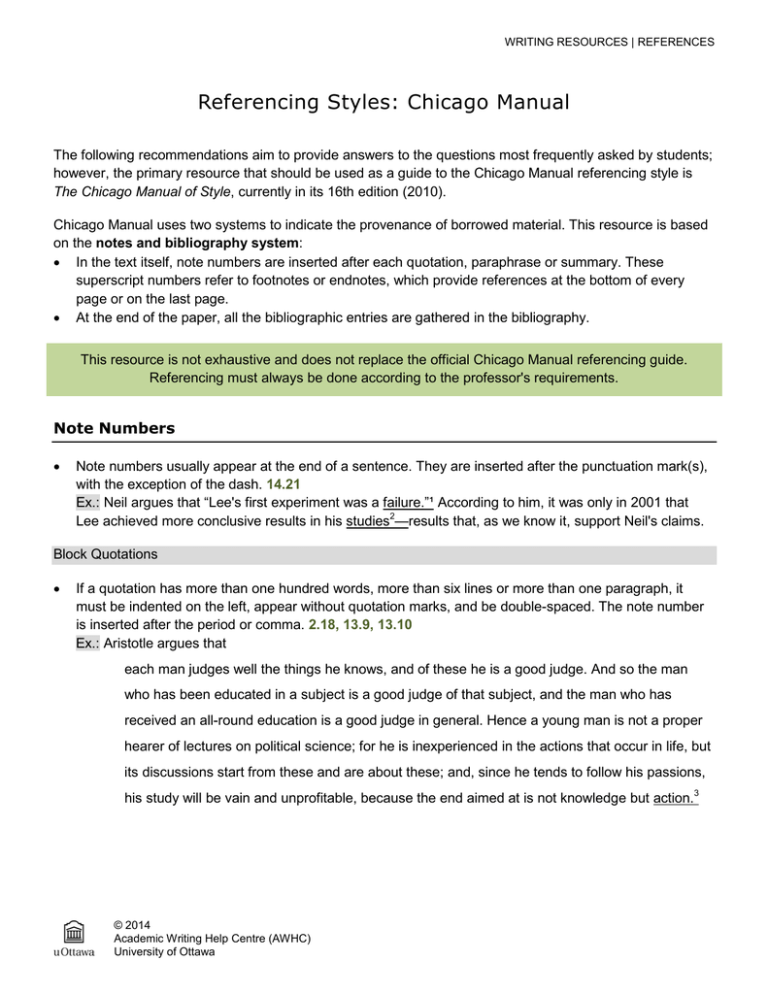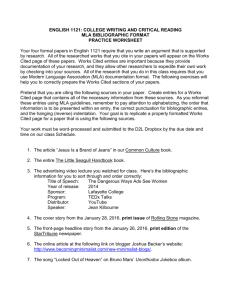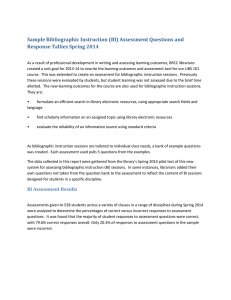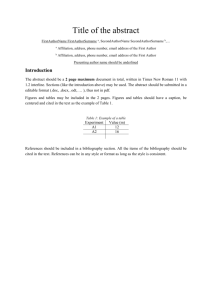Referencing Styles: Chicago Manual
advertisement

WRITING RESOURCES | REFERENCES Referencing Styles: Chicago Manual The following recommendations aim to provide answers to the questions most frequently asked by students; however, the primary resource that should be used as a guide to the Chicago Manual referencing style is The Chicago Manual of Style, currently in its 16th edition (2010). Chicago Manual uses two systems to indicate the provenance of borrowed material. This resource is based on the notes and bibliography system: • In the text itself, note numbers are inserted after each quotation, paraphrase or summary. These superscript numbers refer to footnotes or endnotes, which provide references at the bottom of every page or on the last page. • At the end of the paper, all the bibliographic entries are gathered in the bibliography. This resource is not exhaustive and does not replace the official Chicago Manual referencing guide. Referencing must always be done according to the professor's requirements. Note Numbers • Note numbers usually appear at the end of a sentence. They are inserted after the punctuation mark(s), with the exception of the dash. 14.21 Ex.: Neil argues that “Lee's first experiment was a failure.”¹ According to him, it was only in 2001 that Lee achieved more conclusive results in his studies2—results that, as we know it, support Neil's claims. Block Quotations • If a quotation has more than one hundred words, more than six lines or more than one paragraph, it must be indented on the left, appear without quotation marks, and be double-spaced. The note number is inserted after the period or comma. 2.18, 13.9, 13.10 Ex.: Aristotle argues that each man judges well the things he knows, and of these he is a good judge. And so the man who has been educated in a subject is a good judge of that subject, and the man who has received an all-round education is a good judge in general. Hence a young man is not a proper hearer of lectures on political science; for he is inexperienced in the actions that occur in life, but its discussions start from these and are about these; and, since he tends to follow his passions, his study will be vain and unprofitable, because the end aimed at is not knowledge but action.3 © 2014 Academic Writing Help Centre (AWHC) University of Ottawa WRITING RESOURCES | REFERENCES Footnotes or Endnotes • The full form is used the first time a source is cited. It contains all the bibliographic information that is included in the bibliographic entry, but the author's name precedes the author's surname, the publishing information appears in parentheses, and the borrowed material's page number is added. 14.15 Ex.: 1. Linda Grant, When I Lived in Modern Times (London: Granta, 2000), 182-83. • The short form is used the subsequent times a source is cited. It contains only the bibliographic information that is needed to locate the source in the bibliography: the author’s surname, the title of the source (which is shortened if it has more than four words) and the page number. 14.25 Ex.: 2. Grant, When I Lived, 195. • When consecutive notes refer to the same source, the second note can replace the recurrent information by ibid. Other Latin expressions, like op. cit. and loc. cit., are no longer used. 14.29, 4.31 Ex.: 3. Linda Grant, When I Lived in Modern Times (London: Granta, 2000), 182-83. 4. Ibid., 130. • Note numbers cannot appear out of sequence, more than once or in the same location. If a comment made in a note applies to more than one location in the text, a cross-reference can lead to it. 14.23 Ex.: 5. See note 2 above. Multiple Authors • If a source has two to three authors, the note includes every author's name. When it includes two surnames, there is no comma between them. 14.18, 14.76 Ex.: 6. Lee Benns and Mary Elisabeth Seldon, Europe: 1939 to the Present (New York: AppletonCentury-Crofts, 1965), 62. 7. James Dylan, Chris Pool, and Diana Snigy, Men and Women in Early Antiquity France (Toronto: Reed and Wright, 2001), 99. • If a source has four or more authors, the note includes only the first author's name, followed by the abbreviation et at. 14.18, 14.76 Ex.: 8. Ken Blair et al., Deadly Viruses (New York: Permanent Press, 2009), 26. Multiple Sources • If multiple sources are provided in a note, they are separated by a semicolon and arranged according to the order in which they are cited in the text. 14.52 Ex.: 9. Bell, "To Imagine Change," 210; Brown, and Green, The Strength Unknown, 24. Indirect Sources • If a source is cited in another source, it is best to use the original source. However, if it cannot be located, the note mentions the original source, followed by the indirect source. 14.273 Ex.: 10. Yuko Tagaki, “Heavenly Fog,” The Southwestern Journal of Poetry 57 (June 1976): 437, quoted in Jason de Freitas, Beauty in Truth: Essays on Keats (New York: Viking Press, 1984), 46. © 2014 Academic Writing Help Centre (AWHC) University of Ottawa WRITING RESOURCES | REFERENCES Bibliography The sources that are cited in a paper are all displayed in a double-spaced list called Bibliography. The bibliographic entries are done with a hanging indent and arranged alphabetically according to the authors' surnames. Whenever it is possible, the authors' full first name is used as opposed to the initials. • If a source has no author, the bibliographic entry is arranged alphabetically according to the first significant word of the title after a, an or the. 14.79 • If a source has a corporate author, the full name is used—not the abbreviation. 14.92 • Article titles are in quotation marks. Capitalization is done in headline style: the first word, the last word and all the major words are capitalized. 14.176 • Book and journal titles are in italics. Capitalization is done in headline style: the first word, the last word and all the major words are capitalized. 14.94, 14.95, 14.179 Multiple Authors • If a source has two or more authors, the bibliographic entry includes every author's name. The first author's name is inverted, and every name is separated by a comma. 14.18, 14.76 Benns, Lee, and Mary Elisabeth Seldon. Europe: 1939 to the Present. New York: Appleton-CenturyCrofts, 1965. Blair, Ken, Jen Gould, Mike Sheffield, and Jen Updyke. Deadly Viruses. New York: Permanent Press, 2009. Dylan, James, Chris Pool, and Diana Snigy. Men and Women in Early Antiquity France. Toronto: Reed and Wright, 2001. Multiple Sources • If multiple sources share the same author, the bibliographic entries are arranged alphabetically according to the first significant word of the title after a, an or the. Only the first entry includes the author's name. Subsequent entries replace the author's name by a three-em dash. 14.64 Davies, Robertson. The Manticore. Toronto: Penguin Group, 1972. ———. Rebel Angels. Toronto: Penguin Group, 1997. ———. Tempest Tost. Toronto: Penguin Group, 2006. Indirect Sources • If a source is cited in another source, it is best to use the original source. However, if it cannot be located, the bibliographic entry mentions only the indirect source. 15.52 © 2014 Academic Writing Help Centre (AWHC) University of Ottawa WRITING RESOURCES | REFERENCES Book Author Name. Book Title. Place of publication: Publisher, Year. Davies, Robertson. The Manticore. Toronto: Penguin Group, 1972. 1. Robertson Davies, The Manticore (Toronto: Penguin Group, 1972), 45. Chapter of a Book Author Name. "Chapter Title." In Book Title, edited by Editor Name, Pages. Place of publication: Publisher, Year. Kirk, Leslie. "The Longest Voyage." In Tales of Adventure, edited by Nick Ames, 118-42. London: Penguin, 1978. 2. Leslie Kirk, "The Longest Voyage," in Tales of Adventure, ed. Nick Ames (London: Penguin, 1978), 136. Article in a Periodical Author Name. "Article Title." Periodical Title Volume, Issue (Year and Month if there is no issue): Pages. Gostin, Lawrence. "Public Health Law in a New Century. Part II: Public Health Powers and Limits." Journal of the American Medical Association 283, no. 22 (2000): 2979-84. 3. Lawrence Gostin, "Public Health Law in a New Century. Part II: Public Health Powers and Limits," Journal of the American Medical Association 283, no. 22 (2000): 2982. Article in an Online Periodical Author Name. "Article Title." Periodical Title Volume, Issue (Year and Month if there is no issue): Pages. URL (accessed Month Day, Year). Gostin, Lawrence. "Public Health Law in a New Century. Part II: Public Health Powers and Limits." Journal of the American Medical Association 283, no. 22 (2000): 2979-84. http://jama.ama-assn.org/cgi/ reprint/283/22/2979 (accessed July 25, 2006). 4. Lawrence Gostin, "Public Health Law in a New Century. Part II: Public Health Powers and Limits," Journal of the American Medical Association 283, no. 22 (2000): 2982, http://jama.ama-assn.org/cgi/reprint/ 283/22/2979 (accessed July 25, 2006). Website Author Name. "Page Title." Section, Website Title/Owner. Date of publication. URL (accessed Month Day, Year). McDonald, Kara C. "Trouble Turnover on UN Security Council." Expert brief, Council on Foreign Relations. October 15, 2009. http://www.cfr.org/publication/20407/turnover_on_the_un_security_council.html (accessed October 16, 2009). 5. Kara C. McDonald, "Trouble Turnover on UN Security Council," Expert brief, Council on Foreign Relations, October 15, 2009, http://www.cfr.org/publication/20407/turnover_on_the_un_security_council. html (accessed October 16, 2009). © 2014 Academic Writing Help Centre (AWHC) University of Ottawa



